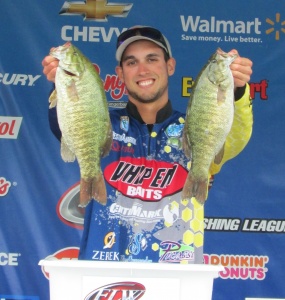When people hear the phrase drop shot, many things come to mind. Some of the things that would spring up in your mind would probably be: fishing slow, light line, spinning rods, and tough conditions. Those are all things that can be tied to the drop shot, but it is much more versatile than that. In this blog we’ll dispel some of these common misconceptions and give you all some new insight on the drop shot rig.
Myth #1: The drop shot is something that is always fished slow.
Although the drop shot is definitely used in this manner, it is not always the most effective way to fish it. I like to use it at times as a search bait and cover a lot of water. A time when this is most effective can be the prespawn spawn and postspawn phase. In the prespawn fish are looking to fatten up for the rigors of the spawn and can stack up together on stopping points along that way. A great way to find them, especially Great Lakes smallmouth, is to cast and drag quickly around likely areas. Once you get bit, generally there are more fish in the area so you can generally slow down and catch more. This is also true at times in the postspawn phase. As the fish filter out of spawning areas they will group up in feeding areas as they try to recuperate on their way to summer areas.
Myth #2: When drop shotting you want to always use light line.
This too is a common misconception. Although light line can be more effective in ultra clear situations, it can also be a major handicap in heavy cover. Power shotting is a variation of the technique in which heavier tackle is used; sometimes up to 20 lb test fluorocarbon. This is most effective when fishing around thick vegetation like you would encounter say in Florida. It can sometimes be the ticket when those fish have seen every flipping presentation from other anglers.
Myth #3: A spinning rod is always used when drop shotting.
Once again, this is a fallacy. Although a spinning rod is most effective when using light line, a baitcaster can be much more effective in those close quarter, flipping type scenarios you would encounter when power shotting. Using a baitcaster in this scenario would give you more leverage which is important because you want to get the fish out of and away from the cover that it can use against you. There are also many angler’s out there that feel more comfortable with baitcasters and use them even when drop shotting light line. It’s more of a confidence thing and if it is more comfortable you should definitely go that route.
Myth #4: The drop shot is most effective when the conditions are tough and other techniques seem to not be working.
Cold fronts, wind changes, and algae blooms are some things that can spell disaster when you are looking to hit the water. These are also times a drop shot can be very effective, but not necessarily where it can excel. As mentioned before, a drop shot can be a great search tool, it can also be the primary pattern on a lot of fisheries. The Great Lakes are a place where a drop shot can be extremely effective nearly all of the time and in every season. Smallmouth waters seem to be places where this is more often the case than primarily largemouth waters. I have caught all three species, Largemouth, Smallmouth, and Spotted Bass, on a drop shot and under varying circumstances. It may not be the primary pattern at all times, but it definitely can prove to be one of the most effective. Look at what Aaron Marten’s did with it on the Mississippi River the past two seasons on the Elite Series when power fishing patterns seemed to dominate.
Just remember the key to being a consistent and successful angler is having the ability to adapt to all kinds of situations. The drop shot has the versatility to complement you, as anglers, in just about any situation that can arise. I hope you all have gained some more insight into the drop shot technique and can look at it with a more open mind.
 To learn more about Professional Angler Destin DeMarion visit: http://destindemarion.com
To learn more about Professional Angler Destin DeMarion visit: http://destindemarion.com